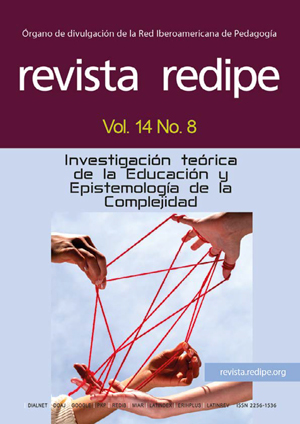Digital ecosystems for electrostatica learning: Interactive experiences, level of mental model evolution and linear regression analysis
Main Article Content
Keywords
Mental model, Digital learning ecosystem, Electrostatics, Formative assessment, Competency space, Educational intervention, Quasi-experimental design, Learning analytics
Abstract
This article partially presents the results of a doctoral research that analyzed the evolution of the mental model (MM) towards the conceptual model in the learning of electrostatic physics. The study was carried out with four (4) groups for a total of sixty-six (66) students of secondary and technological education from four (4) educational institutions in Facatativá and Bogotá. The research was based on the need to design digital learning ecosystems with ontological structures, interactive experiences and continuous monitoring mechanisms that favor the understanding of abstract concepts. Through an interpretative approach and a quasiexperimental design with pre- and post-test for the four (4) groups, which integrated qualitative and quantitative methods, an ecosystem was implemented where the question presented to the students was the central axis of navigation, additionally allowing detailed interaction data to be recorded. The results suggest that students who actively interact with the resources of the digital ecosystem —including guiding questions, experiences with analog and digital elements, videos, readings and *feedback* through forums and chats— progressively modify their cognitive structure, approaching the conceptual model validated by the scientific community. An instrument was designed, piloted and validated to monitor the evolution of the MM at five levels, under the conceptual category space of competencies for learning. The statistical analysis, based on multiple linear regression, revealed significant relationships between the evolution of the mental model and variables such as type and frequency of interaction, number of questions answered, browsing time and sociodemographic factors. A statistically significant impact on learning outcomes (large effect size, Cohen’s d) was observed, although the absence of a control group requires caution in attributing direct causality to the intervention. The findings indicate that the proposed model has a high degree of replicability in teaching scenarios of electrostatics and other areas of scientific knowledge. Likewise, learning analytics emerged as a key tool to understand the dynamics of the ecosystem and adjust its pedagogical and technological components. In short, learning is conceived as a dynamic process linked to the evolution of mental models through action and perception, mediated by active interaction with carefully designed digital environments.
References
Benítez, M. (2023). Evolución del modelo mental en electrostática como resultado de la interacción con un ecosistema de aprendizaje. .
Craik, K. J. W. (1943). The nature of explanation. Cambridge University Press.
Dewey, J. (1938). Experience and education. Macmillan.
Doignon, J. P., & Falmagne, J. C. (1985). Spaces for the assessment of knowledge. International Journal of Man-Machine Studies, 23(2), 175–196.(https://doi. org/10.1016/S0020-7373(85)80031-6)
Falmagne, J. C., Cosyn, E., Doignon, J. P., & Thiéry, N. (2013). Knowledge spaces: Applications in education. Springer. https://doi.org/10.1007/978-3-642- 35329-2
Gibson, J. J. (1977). The theory of *affordances*. In R. Shaw & J. Bransford (Eds.), Perceiving, acting, and knowing: Toward an ecological psychology (pp. 67–82). Lawrence Erlbaum.
Gisbert, M., & Johnson, M. (2015). La competencia digital de los futuros docentes: una perspectiva desde las universidades catalanas. Revista Interuniversitaria de Formación del Profesorado, 83(29.3), 41–58.
Greca, I. M., & Moreira, M. A. (1998). Mental models, conceptual models, and modeling. International Journal of Science Education, 20(1), 1–14.
Greca, I. M., & Moreira, M. A. (2000). Mental models, conceptual models and modeling. International Journal of Science Education, 22(1), 1–11. https:// doi.org/10.1080/095006900289976
Greca, I. M., & Moreira, M. A. (2003). El papel de los modelos mentales y los modelos conceptuales en el proceso de enseñanza y aprendizaje de la física. Revista Electrónica de Enseñanza de las Ciencias, 2(2), 234–256.
Guzmán, A. (2016). Ecosistemas de aprendizaje mediados por Tecnologías de la Información y la Comunicación (TIC): caracterización y desarrollo. Educación y Educadores, 19(1), 11–27.
Johnson-Laird, P. N. (1983). Mental models: Towards a cognitive science of language, inference, and consciousness. Harvard University Press.
Johnson-Laird, P. N. (2006). How we reason. Oxford University Press.
Llinás, R. (2003). El cerebro y el mito del yo. Fondo de Cultura Económica.
Maldonado, G. (2019). Diseño de experiencias de aprendizaje significativo con mediación tecnológica. Revista Educación y Desarrollo Social, 13(2), 59–72.
Moreira, M. A. (1999). Teoría del aprendizaje significativo: Un enfoque cognoscitivo. Santillana.
Morin, E. (1990). Introducción al pensamiento complejo. Gedisa
Motz, R., & Rodés, V. (2013). Ecosistemas de aprendizaje en red. Revista de Universidad y Sociedad del Conocimiento, 10(2), 18–32.
Norman, D. A. (1999). Affordance, conventions, and design. Interactions, 6(3), 38–43. https://doi.org/10.1145/301153.301168



